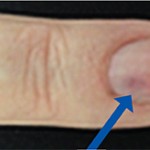 Palmoplantar and nail psoriasis significantly affect a patient’s quality of life. This negative impact can lead to reduced mobility, functional impairment and physical discomfort. In November 2017, data presented at the 8th International Congress of Psoriasis from Gene to Clinic in London showed that secukinumab treatment sustains improvements in nail and palmoplantar psoriasis for more than two years.1
Palmoplantar and nail psoriasis significantly affect a patient’s quality of life. This negative impact can lead to reduced mobility, functional impairment and physical discomfort. In November 2017, data presented at the 8th International Congress of Psoriasis from Gene to Clinic in London showed that secukinumab treatment sustains improvements in nail and palmoplantar psoriasis for more than two years.1
GESTURE was a randomized, placebo-controlled, clinical trial investigating the safety and efficacy of 150 and 300 mg doses of subcutaneous secukinumab in patients (n=205) with moderate to severe palmoplantar psoriasis. It is the largest and longest duration study of secukinumab evaluating this patient population. Secukinumab’s effect on sole skin and palm clearance was determined using the Palmoplantar Investigator’s Global Assessment (ppIGA) and Palmoplantar Psoriasis Area and Severity Index (ppPASI). Positive effects on quality of life were assessed via the Dermatology Life Quality Index (DLQI) and palmoplantar Quality of Life Instrument (ppQLI) scores.
The study results showed that 59% of 300 mg secukinumab-treated patients and 53% of 150 mg secukinumab-treated patients obtained clear or almost clear palms and soles after two and a half years, as measured by ppIGA. Consistent benefits were seen in changes in the ppPASI score. The safety of secukinumab did not differ from other secukinumab clinical trials.
A second clinical trial, TRANSFIGURE, was a double-blind, randomized, placebo-controlled Phase 3b study investigating the long-term safety and efficacy of 150 and 300 mg doses of secukinumab in patients (n=198) with moderate to severe nail psoriasis. This study evaluated the superiority of these dosing regimens compared with placebo. Clinical effectiveness was evaluated at two and a half years using the Nail Psoriasis Severity Index (NAPSI) and Psoriasis Area and Severity Index (PASI). Quality of life effect was evaluated with the Nail Assessment in Psoriasis and Psoriatic Arthritis (NAPPA) and EuroQOL 5-Dimension Health Status Questionnaire (EQ-5D).
In the study, a substantial NAPSI improvement from baseline of -73% for 300 mg secukinumab-treated patients and -63% for 150 mg secukinumab-treated patients was attained and sustained for up to two-and-a-half years. Improved NAPPA and EQ-5D scores highlighted the benefits to patient quality of life. Patients reported decreased discomfort and pain.
These studies are the first to confirm a biologic as both a safe and effective long-term treatment for palmoplantar and nail psoriasis.
Michele B. Kaufman, PharmD, BCGP, is a freelance medical writer based in New York City and a pharmacist at New York Presbyterian Lower Manhattan Hospital.


